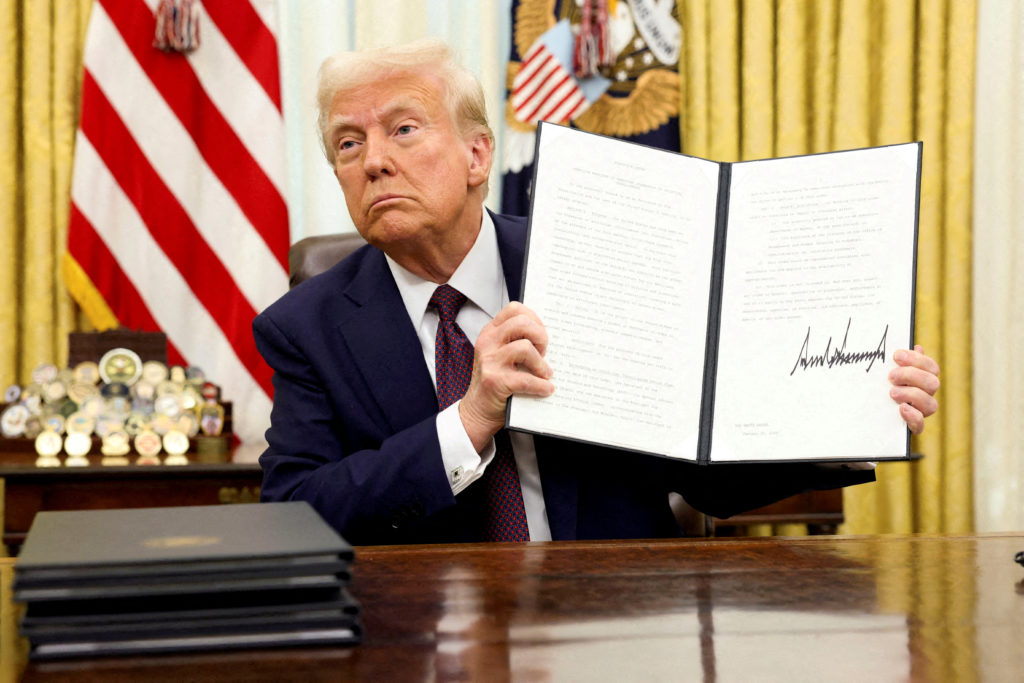Fuel Prices This Month: The Impact of Trump Tariffs

FILE PHOTO: U.S. President Donald Trump holds a signed executive order on AI, in the Oval Office of the White House, in Washington, U.S., January 23, 2025./File Photo
Fuel Prices This Month: The Impact of Trump Tariffs
Fuel prices, a major factor in everyday life for many consumers, are influenced by a range of factors, from global oil supply to geopolitical events. One major influence on fuel costs over the past several years has been the trade policies and tariffs imposed by former President Donald Trump, particularly those targeting foreign goods, including oil and energy resources. As we approach February 2025, many are asking how these tariffs, and the broader economic policies of the Trump era, have shaped fuel prices in the current month.
In this article, we’ll explore how Trump’s tariffs have influenced fuel prices, what’s driving changes in cost this month, and how the lingering effects of past policies continue to shape the fuel market.

1. The Context of Trump’s Tariffs on Energy and Fuel
During his tenure as president, Donald Trump enacted several trade policies aimed at reducing the U.S. trade deficit and promoting American manufacturing. Among these were tariffs on steel, aluminum, and a variety of Chinese goods. While Trump’s tariffs primarily focused on industrial sectors, the energy sector was also affected in some indirect ways.
In 2018, Trump introduced tariffs on steel and aluminum, which resulted in higher costs for the production of energy infrastructure, such as pipelines and refineries. These tariffs indirectly impacted the cost of refining and producing fuel. Additionally, Trump’s “America First” energy policies pushed for greater U.S. oil production through incentives for domestic drilling, reducing dependency on foreign oil. While this resulted in greater energy independence, it also created new challenges related to the transportation and refining of oil.
At the same time, the tariffs on Chinese goods and the trade war with China affected global trade relations, which led to market volatility. Fuel prices, which are inherently tied to global oil markets, were influenced by these shifts in international economic relations.
2. Current Fuel Price Trends: How They Have Been Affected
As of February 2025, fuel prices have been fluctuating, but they remain relatively high compared to pre-2017 levels. This increase can be attributed to a variety of factors, including:
- Global Oil Supply and Demand: The biggest determinant of fuel prices is the global price of crude oil, which is influenced by supply and demand dynamics. Trump’s push for U.S. energy independence reduced the country’s reliance on foreign oil, but global oil production remained heavily influenced by OPEC and geopolitical events, such as the war in Ukraine and instability in the Middle East. These factors often push oil prices up, which, in turn, raises fuel prices.
- Refining Costs: U.S. refineries have faced increased costs due to tariffs on imported steel and aluminum, which impacted the infrastructure needed for refining. Although the U.S. has expanded its domestic oil production, refining capacity remains a critical bottleneck in fuel distribution. Tariffs on materials needed for refinery upgrades led to higher operational costs, which were ultimately passed down to consumers through higher fuel prices.
- China and Global Trade Impact: While the trade war with China ended with the signing of Phase One of the trade deal in early 2020, the effects on global trade dynamics linger. Disruptions in the global supply chain and changes in demand for oil and fuel products have had long-term consequences. Although fuel prices have stabilized in some regions, global trade relations, particularly with China—the world’s largest importer of oil—have had a lasting influence on the market.
3. Fuel Prices in February 2025: What to Expect
This month, February 2025, fuel prices are seeing an uptick compared to the same time last year, largely due to a variety of factors that are not solely attributed to Trump’s tariffs but are influenced by their legacy. Key contributors include:
- Oil Price Fluctuations: In early February 2025, crude oil prices have risen, partially due to OPEC’s continued efforts to limit production in order to maintain stable prices. This has resulted in a steady increase in gasoline and diesel prices at the pump, which are likely to continue rising through the month.
- Refining Shutdowns and Maintenance: In many parts of the U.S., seasonal maintenance at refineries has begun, which can temporarily reduce refining capacity. This reduces the supply of gasoline and diesel, causing a short-term spike in prices. These refinery slowdowns are often exacerbated by higher production costs, which have been influenced by tariffs imposed during the Trump administration.
- Geopolitical Tensions: Ongoing geopolitical issues, particularly in oil-producing regions, continue to push prices higher. The Trump administration’s policies—though focused on energy independence—did little to eliminate the impact of global instability on fuel prices. As tensions rise in parts of the Middle East and Eastern Europe, fuel prices tend to be affected by fear of supply disruptions.
- Domestic Energy Policies: Trump’s push for energy independence through increased domestic oil production did create a boost for U.S. energy companies, but it also resulted in infrastructure challenges. As the U.S. produced more oil, there were bottlenecks in transport and storage capacity. This strained the system during periods of high demand, contributing to price volatility.
4. Impact on Consumers: Higher Prices and Shifting Behaviors
For consumers, the impact of rising fuel prices is being felt in various ways this month. As gas prices increase, household budgets are stretched further, especially for those who rely on their vehicles for commuting or travel. Businesses that depend on fuel, such as transportation and logistics companies, are also experiencing higher operational costs, which may be passed on to consumers in the form of higher prices for goods and services.
Consumers are increasingly turning to electric vehicles (EVs) and hybrid models as a way to mitigate the impact of rising fuel costs. This shift toward alternative energy sources and cleaner transportation options may be a long-term effect of higher fuel prices, spurred by both Trump-era policies and current economic conditions.
5. The Future: What’s Next for Fuel Prices?
Looking ahead, the long-term effects of Trump’s tariffs on fuel prices remain to be fully realized. While the trade policies of the past continue to have lingering effects on the global fuel market, several factors will continue to play a role in shaping prices moving forward:
- The Transition to Renewable Energy: With the global push toward renewable energy and electric vehicles, demand for fossil fuels may begin to decline over time, which could stabilize fuel prices. However, in the short term, supply and demand for oil, refining capacity, and geopolitical tensions will continue to be major drivers.
- Energy Independence and Infrastructure: U.S. energy independence, a key goal of Trump’s policies, has not been fully realized, and challenges remain in terms of refining capacity and transportation infrastructure. These ongoing issues are likely to keep fuel prices volatile in the coming months.
Conclusion: A Mixed Legacy on Fuel Prices
The legacy of Trump’s tariffs continues to have an impact on fuel prices as we move into 2025. While his administration pushed for greater energy independence, it also created infrastructure challenges that have contributed to the rising costs of refining and distribution. Alongside global factors, such as geopolitical tensions and oil production cuts, consumers are seeing a rise in fuel prices this month. While the long-term effects of these tariffs are still unfolding, it’s clear that the policies enacted during Trump’s presidency continue to influence fuel markets today. As we look toward the future, the evolving landscape of energy, trade, and market dynamics will continue to shape how much consumers pay at the pump.





